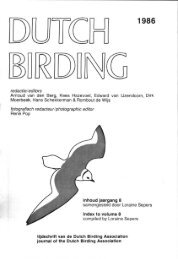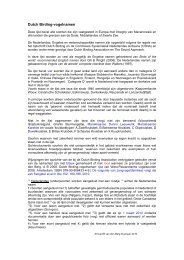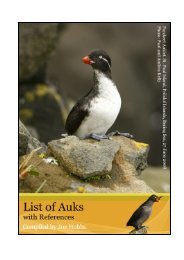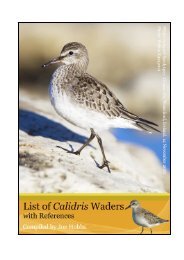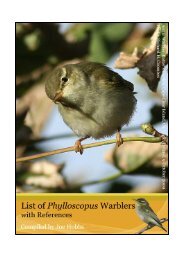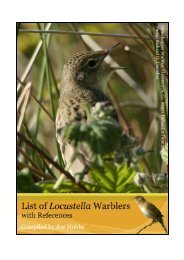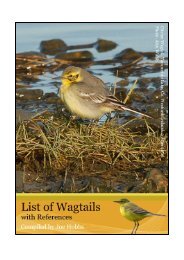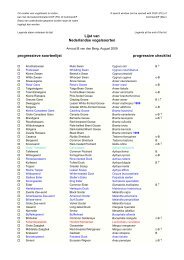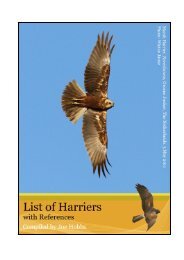List of Hippolais & Iduna with references - Dutch Birding
List of Hippolais & Iduna with references - Dutch Birding
List of Hippolais & Iduna with references - Dutch Birding
You also want an ePaper? Increase the reach of your titles
YUMPU automatically turns print PDFs into web optimized ePapers that Google loves.
IntroductionI have endeavoured to keep typos, errors, omissions etc in this list to a minimum, however whenyou find more I would be grateful if you could mail the details during 2013 to: josephobbs@gmail.com.Grateful thanks to Ross Ahmed and Martin Garner (http://birdingfrontiers.com) for the cover images.All images © the photographers.Joe HobbsIndexThe general order <strong>of</strong> species follows the International Ornithologists' Union World Bird <strong>List</strong> (Gill, F. &Donsker, D. (eds.) 2012. IOC World Bird <strong>List</strong>. Available from: http://www.worldbirdnames.org/[version 3.2 accessed October 2012]).VersionVersion 1.7 (January 2013).CoverMain image: Booted Warbler. Sarykopa, Aqtobe, Kazakhstan. 17 July 2010. Picture by Ross Ahmed.Vignette: Sykes’s Warbler. Tresta Yard, Fetlar, Shetland. 6 October 2010. Picture by Martin Garner.SpeciesPage No.Booted Warbler [<strong>Iduna</strong> caligata] 4Dark-capped Yellow Warbler [<strong>Iduna</strong> natalensis] 4Eastern Olivaceous Warbler [<strong>Iduna</strong> pallida] 7Icterine Warbler [<strong>Hippolais</strong> icterina] 12Melodious Warbler [<strong>Hippolais</strong> polyglotta] 11Mountain Yellow Warbler [<strong>Iduna</strong> similis] 4Olive-tree Warbler [<strong>Hippolais</strong> olivetorum] 10Sykes’s Warbler [<strong>Iduna</strong> rama] 6Thick-billed Warbler [<strong>Iduna</strong> aedon] 3Upcher’s Warbler [<strong>Hippolais</strong> languida] 10Western Olivaceous Warbler [<strong>Iduna</strong> opaca] 91
Relevant PublicationsAli, S. & Dillon, R.S. 1973 & 1997. Handbook <strong>of</strong> the Birds <strong>of</strong> India and Pakistan, Volume 8 - Warblersto Redstarts. Oxford University Press.Baker, K. 1997. Warblers <strong>of</strong> Europe, Asia and North Africa. Christopher Helm, London.Cramp, S. & Brooks, D.J. (eds.) 1992. Handbook <strong>of</strong> the Birds <strong>of</strong> Europe, the Middle East and NorthAfrica, The Birds <strong>of</strong> the Western Palearctic, Volume 6 - Warblers. Oxford University Press.del Hoyo, J. et al (eds.) 2006. Handbook <strong>of</strong> the Birds <strong>of</strong> the World Volume 11, Old World Flycatchersto Old World Warblers. Lynx Edicions, Barcelona.Jenni, L. & Winkler, R. 1994. Moult and Ageing <strong>of</strong> European Passerines. Academic Press.Kennerley, P. & Pearson, D. 2010. Reed and Bush Warblers. Christopher Helm, A & C Black.Moore, A. & Wright, B. 1983. A Field Guide to the Warblers <strong>of</strong> Britain and Europe. Oxford UniversityPress.Parkin, D.T. & Knox, A.G. 2010. The Status <strong>of</strong> Birds in Britain & Ireland. Christopher Helm.Parmenter, T. & Byers, C. 1991. A Guide to the Warblers <strong>of</strong> the Western Palearctic. Bruce ColemanBooks, Uxbridge.Sample, G. 2003. Collins Field Guide: Warbler Songs and Calls <strong>of</strong> Britain and Europe (three CDs).Harper Collins.Shirihai, H. et al 1996. The Macmillan Birder’s Guide to European and Middle Eastern Birds.Macmillan Press, London and Basingstoke.Simms, E. 1985. British Warblers. Collins, London.Snow, D.W. & Perrins, C.M. (eds.) 1998. The Birds <strong>of</strong> the Western Palearctic Concise EditionVolume 2, Passerines. Oxford University Press.Svensson, L. 1992. Identification Guide to European Passerines (4th edition). Privately Published,Stockholm.Urban, E.K. et al 1997. The Birds <strong>of</strong> Africa: Volume V - Thrushes to Puffback Flycatchers. AcademicPress, London.van Duivendijk, N. 2010 & 2011. Advanced Bird ID Guide, The Western Palearctic. New Holland.Vinicombe, K. et al. 1989. The Macmillan Field Guide to Bird Identification. Macmillan Press, Londonand Basingstoke.Williamson, K. 1968. Identification for Ringers 1: The Genera Cettia, Locustella, Acrocephalus and<strong>Hippolais</strong>, 3rd ed. BTO.General NotesAlström, P. et al 2006. Phylogeny and classification <strong>of</strong> the avian superfamily Sylvioidea. MolecularPhylogenetics and Evolution 38(2): 381-397.Badyaev, A.V. & Leaf, E.S. 1997. Habitat Associations <strong>of</strong> Song Characteristics in Phylloscopus and<strong>Hippolais</strong> Warblers. The Auk 114(1). 40-46.Baker, K. 1996. Ageing passerines: some practical examples. <strong>Birding</strong> World 9(7): 280-282.Cody, M.L. 1978. Habitat Selection and Interspecific Territoriality among the Sylviid Warblers <strong>of</strong>England and Sweden. Ecological Monographs 48(4): 351-396.Collinson, M. 2006. Splitting headaches? Recent taxonomic changes affecting the British andWestern Palearctic lists. British Birds 99(6): 306-323 (313-314).Fraser, M. 2004. <strong>List</strong>Check (Acrocephalus and <strong>Hippolais</strong> warblers). Birdwatch 148: 14.Fraser, M. 2010. <strong>List</strong>Check (Relationships: Warblers). Birdwatch 212: 49.Fregin, S. et al 2009. Multi-locus phylogeny <strong>of</strong> the family Acrocephalidae (Aves: Passeriformes) –The traditional taxonomy overthrown. Molecular Phylogenetics and Evolution 52(3): 866-878.Fregin, S. et al 2012. Pitfalls in comparisons <strong>of</strong> genetic distances: A case study <strong>of</strong> the avian familyAcrocephalidae. Molecular Phylogenetics and Evolution 62(1): 319-328.Gantlett, S. 1998. Bird forms in Britain. <strong>Birding</strong> World 11(6): 232-239.Harrap, S. & Lewington, I. 1990. Hinweise zur Unterscheidung der Spötter <strong>Hippolais</strong> im Freiland[Field identification <strong>of</strong> <strong>Hippolais</strong> warblers]. Limicola 4(2): 49-73.Harrap, S. 1990. Identification <strong>of</strong> <strong>Hippolais</strong> Warblers. <strong>Birding</strong> World 3(8): 268-272.Harrop, H. 1994. Masterguide (Welcome to the Hippodrome). Birdwatch 28: 40-44.Helbig, J.A. & Seibold, I. 1999, Molecular phylogeny <strong>of</strong> Palearctic-African Acrocephalus and<strong>Hippolais</strong> warblers (Aves: Sylvviidae). Molecular Phylogenetics and Evolution 11: 246-260.King, J. 1998. OrnithoNews (Redifining Acrocephalus and <strong>Hippolais</strong>). <strong>Birding</strong> World 11(2): 42.Knox, A.G. et al 2002. Taxonomic recommendations for British birds. Ibis 144: 707-710.Leisler, B. et al 2002. Evolution <strong>of</strong> Breeding Systems in Acrocephaline Warblers. The Auk 119(2):379-390.2
Mitchell, D. 2011. Birds <strong>of</strong> Britain: subspecies checklist v1.1. [online PDF]. Available from:http://www.birdwatch.co.uk/categories/articleitem.asp?cate=22&topic=155&item=800 [AccessedJuly 2011].Norman, S.C. 1997. Juvenile wing shape, wing moult and weight in the family Sylviidae. Ibis 139(4):617-630.Parkin, D.T. et al 2004. Species limits in Acrocephalus and <strong>Hippolais</strong> warblers from the WesternPalearctic. British Birds 97(6): 276-299.Riddington, R. 2000. Fair Isle. <strong>Dutch</strong> <strong>Birding</strong> 22(1): 1-12.Sangster, G. 1997. Trends in systematics, Acrocephalus and <strong>Hippolais</strong> relationships: shaking thetree. <strong>Dutch</strong> <strong>Birding</strong> 19(6): 294-300.Sangster, G. et al 2009. Taxonomic recommendations for British birds: Sixth report. Ibis 152: 180-186.Sangster, G. et al 2011. Taxonomic recommendations for British Birds: seventh report. Ibis 153(4):883-892.Shirihai, H. et al 1996. Identification <strong>of</strong> <strong>Hippolais</strong> warblers. British Birds 89(3): 114-138.Susanna, K. et al 2004. Phylogenetic analyses <strong>of</strong> the diversity <strong>of</strong> moult strategies in Sylviidae inrelation to migration. Evolutionary Ecology 18(1): 85-105.Svensson, E. & Hedenström, A. 1999. A phylogenetic analysis <strong>of</strong> the evolution <strong>of</strong> moult strategies inWestern Palearctic warblers (Aves: Sylviidae). Biological Journal <strong>of</strong> the Linnean Society 67(2):263-276.van den Berg, A.B. 2012. <strong>Dutch</strong> <strong>Birding</strong>-vogelnamen [<strong>Dutch</strong> <strong>Birding</strong> bird names] [online PDF].Available from: http://www.dutchbirding.nl/page.php?page_id=228 [Accessed January 2012].Thick-billed Warbler<strong>Iduna</strong> aedon [Pallas 1776, SE Transbaikalia, E Siberia, Russia][I.a. aedon] Tomsk E to Kansk and S to Lake Teletskoy (Altai, SC Siberia) & E Sayan Mts (SCSiberia) and adjacent NW Mongolia. Winters Nepal, E & S India E to Myanmar & Thailand.[I.a. rufescens] E Siberia & NE Mongolia E to Sea <strong>of</strong> Japan and S to NE China. Winters S China &Indochina.Treated by del Hoyo et al 2006 and Parkin & Knox 2010 as Acrocephalus aedon.Treated by Kennerley & Pearson 2010 as Phragamaticola aedon.Note: I.a. rufescens is a synonym <strong>of</strong> I.a. stegmanni.1st WP Record: 6 October 1955. Leogh, Fair Isle, Shetland. K.Williamson, V.Thom, I.J.Ferguson-Lees & H.E.Axell. Trapped (Williamson et al 1956).Adelson, D.I. & Purandare, R. 2004. Sighting <strong>of</strong> Thick-billed Warbler Phragmaticola aedon nearPanchgani, Maharashtra, India. Indian Birds 1(6): 87-88.Bond, G.M. 1975. The correct spelling <strong>of</strong> Jerdon’s generic name for the Thick-billed Warbler. Bulletin<strong>of</strong> the British Ornithologists’ Club 95(2): 50-51.Bull, A. 2003. Britain’s first spring Thick-billed Warbler. <strong>Birding</strong> Scotland 6(3): back cover.Chattopadhyay, S. 1978. Occurrence <strong>of</strong> the Thick-billed Warbler Phragmaticola aedon rufescensStegmann at Baj Baj, West Bengal. Journal <strong>of</strong> the Bombay Natural History Society 75(2): 491-492.Dickinson, E.C. & Gregory, S.M.S. 2006. Systematic notes on Asian birds. 55. A re-examination <strong>of</strong>the date <strong>of</strong> publication <strong>of</strong> Jerdon’s Second Supplement to the Catalogue <strong>of</strong> the Birds <strong>of</strong> southernIndia. Zoologische Mededelingen 80: 169-178.Eischer, K. 1995. The Thick-billed Warbler in Finland. <strong>Birding</strong> World 8(1): 10-11.Grieve, A. 1992. First record <strong>of</strong> Thick-billed Warbler Acrocephalus aedon in Egypt. Sandgrouse14(2): 123-124.Harvey, P. 2001. The Thick-billed Warbler on Shetland. <strong>Birding</strong> World 14(9): 372-373.Harvey, P.V. & Shaw, K.D. 2001. Thick-billed Warbler on Out Skerries - the third British record.<strong>Birding</strong> Scotland 4: 154-158.Jännes, H. 1995. Paksunokka-kerttunen, kerttuseksi helppo tuntea [Thick-billed Warbler, easy tosex]. Alula 1(1): 18-20.Lekagul, B. et al 1985. Birdwatching in Thailand. British Birds 78(1): 2-39 (25-28).Lidster, J. 2003. Monthly Marathon Solution (Thick-billed Warbler). British Birds 96(6): 312-313.Millington, R. 2001. Eastern vagrants: a photo-gallery. <strong>Birding</strong> World 14(8): 333-342 (338).Moores, N. 2007. Selected records from Socheong Island, South Korea. Forktail 23: 102-124 (114).Sharrock J.T.R. 1983. Mystery photographs (Thick-billed Warbler). British Birds 76(4): 186-187.Shaw, D. 2003. Reports (Fair Isle's in the thick <strong>of</strong> it). Birdwatch 133: 50.Shaw, D. 2003. The Thick-billed Warbler on Fair Isle. <strong>Birding</strong> World 16(5): 206-208.3
Shaw, K. 2001. Reports (Shetland birders net the big one. Thick-billed warbler: Shetland, 14September 2001). Birdwatch 113: 48-49.Shirihai, H. et al 1995. Identification and taxonomy <strong>of</strong> large Acrocephalus warblers. <strong>Dutch</strong> <strong>Birding</strong>17(5): 229-239.Simpson, J.H. et al 1973. Thick-billed Warbler in Shetland. Scottish Birds 7: 262-263.van Bemmelen, R.S.A. & Groenendijk, D. 2005. Masters <strong>of</strong> Mystery Solution (Thick-billed Warbler).<strong>Dutch</strong> <strong>Birding</strong> 27(1): 51-52.Watson, G.E. 1985. Replacement name for Acrocephalus aedon rufescens (Stegmann). Bulletin <strong>of</strong>the British Ornithologists’ Club 105: 79.Wei, G. 1984. Breedings habits <strong>of</strong> Thick-billed Warbler (Phragamaticola aedon rufescens, Stegman).Chinese Journal <strong>of</strong> Ecology 3(2): 21-25. [in Chinese].Williamson, K. et al 1956. Thick-billed Warbler at Fair Isle: a new British bird. British Birds 49: 89-93.Williamson, K. et al. Thick-billed Warbler on Fair Isle, pp. 79-82. Found in: Sharrock, J.T.R. &Grant, P.J. 1982. Birds new to Britain and Ireland. T. & A.D. Poyser.Dark-capped Yellow Warbler<strong>Iduna</strong> natalensis [A. Smith 1847, near Port Natal (= Durban), South Africa].[I.n. natalensis] S Tanzania & E Zambia S to E Zimbabwe & E South Africa.[I.n. massaica] SE Sudan & Ethiopia S to E DR Congo, Uganda, Kenya & N Tanzania.[I.n. major] Gabon E to S DR Congo and S to Angola and N & W Zambia.[I.n. batesi] SE Nigeria E & S to N DR Congo.Treated by del Hoyo et al 2006 as Chloropeta natalensis.Other names: African Yellow Warbler, Yellow Flycatcher, Yellow Flycatcher-warbler; Natal YellowWarbler (natalensis).Parkes, K.C. 1987. Taxonomic notes on some African warblers (Aves: Sylviinae). Annals <strong>of</strong> CarnegieMuseum 56: 231-243.Vernon, C.J. 1962. Variation in the nest <strong>of</strong> Chloropeta natalensis. Ostrich 33: 52-53.Mountain Yellow Warbler<strong>Iduna</strong> similis [Richmond 1897, Mount Kilimanjaro at 10,000 feet, Tanzania].Imatong Mts & Dongatona Mts (S Sudan), Mt. Morongole (NE Uganda), Rwenzoris Mts S to ItombweForest & Mt. Kabobo (the highlands <strong>of</strong> E DR Congo, W Rwanda & W Burundi), Mt Kenya, Mt Elgon &Mt. Kenya (Kenya) and Crater Highlands (Tanzania) E to Mt. Kilimanjaro and Ukagurus Mts S toNjombe (N & E Tanzania) and the Nyika plateau (on the Zambia-Malawi border).Treated by del Hoyo et al 2006 as Chloropeta similis.Other names: Mountain Warbler, Mountain Yellow Flycatcher, Mountain Yellow Flycatcher-warbler,Highland Flycatcher-warbler.Parkes, K.C. 1987. Taxonomic notes on some African warblers (Aves: Sylviinae). Annals <strong>of</strong> CarnegieMuseum 56: 231-243.Booted Warbler<strong>Iduna</strong> caligata [M.H.C. Lichtenstein 1823, Ilek, Ural River, near Orenburg, SW Russia].Extreme SE Finland, W & SW Russia E to Kazakhstan (except most <strong>of</strong> W & S), Dzungaria (extremeNW China), NW Mongolia & SC Siberia. Winters E Indian subcontinent including Bangladesh.Treated by del Hoyo et al 2006 and Parkin & Knox 2010 as <strong>Hippolais</strong> caligata.Other name: Eversmann's Warbler.Eduard Aleksandrovich Eversmann (1794-1860), Russian entomologist and Pr<strong>of</strong>essor <strong>of</strong> Zoology atKazan.Aalto, T. & Dernjatin, P. 2006. Small <strong>Hippolais</strong> - warblers revisited - Booted and Sykes's Warblers.Alula 12(1): 2-8.Baha el Din, S. & Riad, A. 1992. Booted Warbler in Egypt in September 1991. <strong>Dutch</strong> <strong>Birding</strong> 14(5):176-177.Bradshaw, C. & Steele, J. 1995. Mystery Photographs (probable rama Booted Warbler). British Birds88(11): 561-564.British Ornithologists’ Union 2000. British Ornithologists’ Union Records Committee: 26th Report(October 1999). Ibis 142: 177-179.Bushell, C.I. 1984. Notes (Head pattern <strong>of</strong> Booted Warbler). British Birds 77(8): 366.4
Castell, P. & Kirwan, G.M. 2005. Will the real Sykes's Warbler please stand up? Breeding datasupport specific status for <strong>Hippolais</strong> rama and H. caligata, <strong>with</strong> comments on the Arabianpopulation <strong>of</strong> 'booted warbler'. Sandgrouse 27(1): 30-36.Castell, P. 1999. Clamorous Reed Warbler Acrocephalus stentoreus apparently predating nest <strong>of</strong>Booted Warbler <strong>Hippolais</strong> caligata in the United Arab Emirates. Sandgrouse 21(2): 177.Corso, A. 2000. Letters (Tail movements <strong>of</strong> <strong>Hippolais</strong> warblers). <strong>Birding</strong> World 13(12): 508.de Knijff, P. & van Swelm, N.D. 1998. Letter (Mystery warblers in Tselinograd: an attempt to solvepart <strong>of</strong> the problem). British Birds 91(5): 190-192.Dernjatin, P. & Westerbjerg Andersen, M. 2006. Central Asian <strong>Hippolais</strong> warblers. Alula 12(4): 146-153.Dernjatin, P. 2005. Chokpak - Central Asian songbirds. Alula 11(2): 50-58.Dierschke, V. et al 1996. Records <strong>of</strong> Booted Warbler Hippolias caligata in north-eastern Turkey.Sandgrouse 18(2): 66.Fraser, M. 2005. <strong>List</strong>Check (Specific identity. Sykes's and Booted warbler). Birdwatch 158: 59.Grace, K. & Lancaster, A.A.K. 1990. Booted Warbler on Dursey Island, Co. Cork. Irish <strong>Birding</strong> News1(2): 61.Harrap, S. 1988. Identification <strong>of</strong> Olivaceous and Booted Warblers. <strong>Birding</strong> World 1(9): 312-315.Harrap, S. 1989. Letters (Identification <strong>of</strong> Booted Warbler). <strong>Birding</strong> World 2(8): 294.Harvey, P. & Bradshaw, C. 1999. From the Rarities Committee's files: Booted Warblers <strong>with</strong> longsupercilia: the 1976 Fair Isle bird. British Birds 92(9): 477-479.Hirschfeld, E. 1994. On the status <strong>of</strong> Booted Warbler <strong>Hippolais</strong> caligata in the United Arab Emirates.Emirates Bird Report 18: 100-104.Kapanen, M. 1996. Pikkukultarinta - vaatimaton valloittaja [Booted Warbler - a Modest Conquerer].Alula 2(2): 84-88.Kapanen, M. 1997. Photonews. Alula 3(1): 34.Kivivuori, H. 2000. The Booted Warbler (<strong>Hippolais</strong> caligata) breeding for the first time in Finland.Linnut 35(4): 33-35.Kylänpää, J. 2000. Birds <strong>of</strong> Dera Ismail Khan District <strong>of</strong> North West Frontier Province in Pakistan.Forktail 16: 15-28 (25).Lansdown, P. 1986. Mystery photographs (Booted Warbler). British Birds 79(11): 588-589.Leivo, M. & Dernjatin, P. 2000. Kazakhstan - The land <strong>of</strong> the Pallas's Sandgrouse. Alula 6(2): 53-54.Lidster, J.A. 2009. From the Rarities Committee's files: The Green Farm Booted Warbler. BritishBirds 102(11): 617-621.Lindblom, K. 2008. Booted Warbler and Lanceolated Warbler in Finland. Alula 14(2): 84-90.Lindholm, A. & Aalto, T. 2005. The calls <strong>of</strong> Sykes's and Booted Warblers. <strong>Birding</strong> World 18(9): 395-396.<strong>List</strong>er, S. 1993. Letters (Booted or Sykes Warbler). <strong>Birding</strong> World 6(12): 492-493.Martins, R.P. et al 1996. The status <strong>of</strong> passerines in southern Yemen and records <strong>of</strong> the OSMEsurvey in spring 1993. Sandgrouse 17: 54-72 (63).Page, D. 2001. Letters (Separating Acrocephalus and <strong>Hippolais</strong> warblers). British Birds 94(1): 44.Rooke, S. 2000. Monthly Marathon Solution (Booted Warbler). British Birds 93(5): 253-254.Sehhatisabet, M.E. et al 2006. Further significant extensions <strong>of</strong> migrant distribution and breeding andwintering ranges in Iran for over sixty species. Sandgrouse 28(2): 146-155.Shitikov, D. et al 2011. Breeding-site fidelity and dispersal in isolated populations<strong>of</strong> three migratorypasserines. Ornis Fennica 88: 1-10.Singh, A.P. 2000. Birds <strong>of</strong> lower Garhwal Himalayas: Dehra Dun valley and neighbouring hills.Forktail 16: 101-123 (104).Small, B. 2002. Letters (Bill shapes <strong>of</strong> Booted & Sykes's Warblers). <strong>Birding</strong> World 15(4): 170.Svensson, L. 1997. Notes (Mystery warblers in Tselinograd). British Birds 90(4): 152-158.Svensson, L. 1999. Letters (The Kazakh 'mystery warblers' once again). British Birds 92(9): 481-482.Svensson, L. 2001. Identification <strong>of</strong> Western and Eastern Olivaceous, Booted and Sykes's Warblers.<strong>Birding</strong> World 14(5): 192-219.Svensson, L. 2003. <strong>Hippolais</strong> update: Identification <strong>of</strong> Booted Warbler and Sykes's Warbler. <strong>Birding</strong>World 16(11): 470-474.van Bemmelen, R.S.A. & Groenendijk, D. 2004. Masters <strong>of</strong> Mystery Solution (Booted Warbler).<strong>Dutch</strong> <strong>Birding</strong> 26(5): 328-330.van den Berg, A.B. 1989. Kleine Spotvogel te Bloemendaal in september 1988 [Booted Warbler atBloemendaal in September 1988]. <strong>Dutch</strong> <strong>Birding</strong> 11(3): 123-126.Vinicombe, K. 1995. Identification (The ones to watch). Birdwatch 42: 24-30 (30).Wallace, D.I.M. 2000. Letters (Tail movements by eastern <strong>Hippolais</strong>). <strong>Birding</strong> World 13(7): 282.5
Wassink, A. 1983. Kleine Spotvogel op Terschelling in oktober 1982 [Booted Warbler on Terschellingin October 1982]. <strong>Dutch</strong> <strong>Birding</strong> 5(1): 1-5.Watabe, Y. 2005. The First Record <strong>of</strong> Booted Warbler <strong>Hippolais</strong> caligata in Japan. Journal <strong>of</strong> theYamashina Institute for Ornithology 37(1): 14-19.Sykes’s Warbler<strong>Iduna</strong> rama [Sykes 1832, Deccan, India].Lower R Volga, Ural R & N Caspian Sea coast E to E Kazakhstan & W & C Xinjiang (extreme WChina) and S to S Iran, Afghanistan and NW & W Pakistan and NW Oman. Winters Indiansubcontinent.Treated by del Hoyo et al 2006 and Parkin & Knox 2010 as <strong>Hippolais</strong> rama.Col. William Henry Sykes (1790-1872), Indian army and naturalist, one time director <strong>of</strong> the East IndiaCompany and an MP for Aberdeen in later life.Ashby, V. & Annenkova, S. 2004. <strong>Birding</strong> Kazakhstan. <strong>Birding</strong> World 17(6): 242-253.Bradshaw, C. & Steele, J. 1995. Mystery Photographs (probable rama Booted Warbler). British Birds88(11): 561-564.Breek, C.J. et al 2006. Sykes' Spotvogel bij Almere-Haven in oktober 1986 [Sykes's Warbler nearAlmere-Haven in October 1986]. <strong>Dutch</strong> <strong>Birding</strong> 28(4): 219-224.British Ornithologists’ Union 2000. British Ornithologists’ Union Records Committee: 26th Report(October 1999). Ibis 142: 177-179.British Ornithologists’ Union 2004. British Ornithologists’ Union Records Committee: 30th Report(October 2003). Ibis 146: 192-195.British Ornithologists’ Union 2005. British Ornithologists’ Union Records Committee: 31st Report(October 2004). Ibis 147: 246-250.Cade, M. 2000. Bird news (Dorset hosts second-ever Sykes's Warbler). Birdwatch 99: 62.Cade, M. 2000. The Sykes's Warbler in Dorset. <strong>Birding</strong> World 13(7): 274-276.Castell, P. & Kirwan, G.M. 2005. Will the real Sykes's Warbler please stand up? Breeding datasupport specific status for <strong>Hippolais</strong> rama and H. caligata, <strong>with</strong> comments on the Arabianpopulation <strong>of</strong> 'booted warbler'. Sandgrouse 27(1): 30-36.Cooper, D. et al 2002. The Sykes's Warbler in East Sussex. <strong>Birding</strong> World 15(9): 378-380.Corso, A. 2000. Letters (Tail movements <strong>of</strong> <strong>Hippolais</strong> warblers). <strong>Birding</strong> World 13(12): 508.Crouzier, P. 2008. Une Hypolaïs rama en 200 sur l'île d'Ouessant [Sykes’s Warbler on Ushant, newfor France]. Ornithos 15(1): 67-69.de Knijff, P. & van Swelm, N.D. 1998. Letter (Mystery warblers in Tselinograd: an attempt to solvepart <strong>of</strong> the problem). British Birds 91(5): 190-192.Dernjatin, P. & Westerbjerg Andersen, M. 2006. Central Asian <strong>Hippolais</strong> warblers. Alula 12(4): 146-153.Dernjatin, P. 2005. Chokpak - Central Asian songbirds. Alula 11(2): 50-58.Disley, T. 2003. Reports (Sykes's Warbler: North Ronaldsay, Orkney, 29 September-1 October2003). Birdwatch 137: 51.Fågel, P. 2007. Kuwait - A <strong>Birding</strong> Destination at the Southeastern Corner <strong>of</strong> the Western Palearctic.Alula 13(4): 166-174 (169, photo 8).Fraser, M. 2005. <strong>List</strong>Check (Specific identity. Sykes's and Booted warbler). Birdwatch 158: 59.Grace, K. & Lancaster, A.A.K. 1990. Booted Warbler on Dursey Island, Co. Cork. Irish <strong>Birding</strong> News1(2): 61.Harrap, S. 1988. Identification <strong>of</strong> Olivaceous and Booted Warblers. <strong>Birding</strong> World 1(9): 312-315.Harrap, S. 1989. Letters (Identification <strong>of</strong> Booted Warbler). <strong>Birding</strong> World 2(8): 294.Harvey, P. & Bradshaw, C. 1999. From the Rarities Committee's files: Booted Warblers <strong>with</strong> longsupercilia: the 1976 Fair Isle bird. British Birds 92(9): 477-479.Hirschfeld, E. 1994. On the status <strong>of</strong> Booted Warbler <strong>Hippolais</strong> caligata in the United Arab Emirates.Emirates Bird Report 18: 100-104.Jennings, M.C. 2007. Sykes and Clamorous Reed Warblers at Khor Kalba. Phoenix 23: 4.Kerby, M. 2010. The Sykes's Warbler in Northumberland. <strong>Birding</strong> World 23(8): 339-343.Kerby, M. et al 2010. Reports (Sykes for sore eyes. Sykes's Warblers: Druridge Bay Country Park,Northumberland, 15-16 August 2010 and Burrafirth, Unst, 16-17 August 2010). Birdwatch 220: 52-53.Lees, J. 2002. Reports (North Ron back in thick <strong>of</strong> the action). Birdwatch 125: 50-51.Lees, J. et al 2002. The Sykes's Warbler on Orkney. <strong>Birding</strong> World 15(9): 375-377.6
Lindholm, A. & Aalto, T. 2005. The calls <strong>of</strong> Sykes's and Booted Warblers. <strong>Birding</strong> World 18(9): 395-396.<strong>List</strong>er, S. 1993. Letters (Booted or Sykes Warbler). <strong>Birding</strong> World 6(12): 492-493.McGeehan, A. 1990. Olivaceous Warbler on Cape Clear, Co. Cork. Irish <strong>Birding</strong> News 1(2): 62-67.McGeehan, A. 2002. Total birding (Crunch time). <strong>Dutch</strong> <strong>Birding</strong> 24(5): 304-306.Osborn, K. 1993. The Shetland <strong>Hippolais</strong> warbler. <strong>Birding</strong> World 6(11): 437-438.Page, D. 2001. Letters (Separating Acrocephalus and <strong>Hippolais</strong> warblers). British Birds 94(1): 44.Pearson, D.J. et al 2004. The identity <strong>of</strong> some <strong>Hippolais</strong> specimens from Eritrea and the United ArabEmirates examined by mtDNA analysis: a record <strong>of</strong> Sykes's Warbler H. rama in Africa. Ibis 146:683-684.Riddington, R. 2008. Reports (Storm from the east. Siberian Thrush, Brown Flycatcher and Sykes'sWarbler: Fair Isle and Sumburgh, Shetland, September 2008). Birdwatch 197: 54-55.Riddington, R. 2009. From the Rarities Committee's files: The history <strong>of</strong> Sykes's Warbler in Britain.British Birds 102(11): 622-626.Singh, A.P. 2000. Birds <strong>of</strong> lower Garhwal Himalayas: Dehra Dun valley and neighbouring hills.Forktail 16: 101-123 (104).Small, B. 2002. Letters (Bill shapes <strong>of</strong> Booted & Sykes's Warblers). <strong>Birding</strong> World 15(4): 170.Svensson, L. & Millington, R. 2002. Field identification <strong>of</strong> Sykes's Warbler. <strong>Birding</strong> World 15(9): 381-382.Svensson, L. 1997. Notes (Mystery warblers in Tselinograd). British Birds 90(4): 152-158.Svensson, L. 1999. Letters (The Kazakh 'mystery warblers' once again). British Birds 92(9): 481-482.Svensson, L. 2001. Identification <strong>of</strong> Western and Eastern Olivaceous, Booted and Sykes's Warblers.<strong>Birding</strong> World 14(5): 192-219.Svensson, L. 2003. <strong>Hippolais</strong> update: Identification <strong>of</strong> Booted Warbler and Sykes's Warbler. <strong>Birding</strong>World 16(11): 470-474.Thomason, B. et al 2003. The Sykes's Warbler in Shetland. <strong>Birding</strong> World 16(11): 466-469.van Bemmelen, R.S.A. & Groenendijk, D. 2004. Masters <strong>of</strong> Mystery Solution (Booted Warbler).<strong>Dutch</strong> <strong>Birding</strong> 26(5): 328-330.Vinicombe, K. 1995. Identification (The ones to watch). Birdwatch 42: 24-30 (30).Wallace, D.I.M. 2000. Letters (Tail movements by eastern <strong>Hippolais</strong>). <strong>Birding</strong> World 13(7): 282.Eastern Olivaceous Warbler<strong>Iduna</strong> pallida [Hemprich and Ehrenberg 1833, the River Nile, in Egypt and Nubia].[I.p. pallida] W & N Egypt S to N Sudan along the River Nile. Winters C & S Sudan, Eritrea & NEthiopia.[I.p. elaeica] Hungary & Romania E to S Ukraine and Slovenia & Croatia S to Greece and Bulgaria,Turkey, Cyprus and W Syria S to N Israel & W Jordan and N & S Caucasus S to Iraq, W & N Iran, EArabian peninsula and SW & S Kazakhstan S to Uzbekistan, S Turkmenistan & N Afghanistan.Winters C & E Sahel region.[I.p. reiseri] SE Morocco, desert habitats <strong>of</strong> interior Algeria, S Tunisia & Fezzan (SW Libya). Wintersnot precisely established. Northern breeding populations possibly to Senegal, Gambia, Niger & NNigeria and southern breeding populations probably resident.[I.p. laeneni] Lake Chad region, SE Niger, NE Nigeria & W Sudan.[I.p. alulensis] Mangrove coasts <strong>of</strong> the Red Sea, Sudan, Eritrea, Djibouti, Somalia & Bab El Mandab(Yemen).Treated by del Hoyo et al 2006 as <strong>Hippolais</strong> pallida.Other names: Saharan Olivaceous Warbler (reiseri), Chad Olivaceous Warbler (laeneni), MangroveOlivaceous Warbler (alulensis).Aidley, D.J. & Wilkinson, R. 1987. Moult <strong>of</strong> some Palearctic warblers in northern Nigeria. Bird Study34(3): 219-225 (221).Antonov, A. 2004. Smaller Eastern Olivaceous Warbler <strong>Hippolais</strong> pallida elaeica nests suffer lesspredation than larger ones. Acta Ornitologica 39: 87-92.Antonov, A. et al 2007. Aspects <strong>of</strong> breeding ecology <strong>of</strong> the eastern olivaceous warbler (<strong>Hippolais</strong>pallida). Journal <strong>of</strong> Ornithology 148(4): 443-451.Ash, J.S. & Pearson, D.J. 2002. <strong>Hippolais</strong> warblers apparently breeding on the north Somalia coast.Bulletin <strong>of</strong> the British Ornithologists’ Club 122: 222-228.Ash, J.S. et al 2005. A new race <strong>of</strong> Olivaceous Warbler <strong>Hippolais</strong> pallida in Somalia. Ibis 147: 841-843.7
Baha el Din, S. et al 2010. Mangrove Olivaceous Warblers in Egypt - new to the Western Palearctic.<strong>Birding</strong> World 23(5): 215-217.Baha el Din, S. 2011. The Somali race <strong>of</strong> the Olivaceous Warbler identified in mangroves at Bab alMandab. Phoenix 27: 10.Bankovics, A. 1974. Spreading and habitats <strong>of</strong> <strong>Hippolais</strong> pallida elaeica (Lindl.) along the Tisza.Tiscia 9: 105-113.Bankovics, A. 1975. Data on the comparative ecology <strong>of</strong> the scrub warbler (<strong>Hippolais</strong> pallida elaeica(Lindl.)) and its spreading along the Tisza in the years 1973 to 1974. Tiscia 10: 81-83.Baxter, P.A.A. 2001. Racial identification <strong>of</strong> the Olivaceous Warbler at Collieston. <strong>Birding</strong> Scotland 4:13-14.Bradshaw, C. & Steele, J. 1995. Mystery Photographs (probable rama Booted Warbler). British Birds88(11): 561-564.Bradshaw, C. 2000. Letters (Separating Acrocephalus and <strong>Hippolais</strong> warblers). British Birds 93(6):277.Bräunlich, A. & Stei<strong>of</strong>, K. 2001. Neuer Nachweis eines Blassspötters <strong>Hippolais</strong> [pallida] elaeica inDeutschland [Recent record <strong>of</strong> Eastern Olivaceous Warbler <strong>Hippolais</strong> [pallida] elaeica inGermany]. Limicola 15(3): 147-155.British Ornithologists’ Union 2000. British Ornithologists’ Union Records Committee: 26th Report(October 1999). Ibis 142: 177-179.Buttle, C. 1995. The Olivaceous Warbler in Suffolk. <strong>Birding</strong> World 8(8): 293-294.Cade, M. 1999. The Olivaceous Warbler in Dorset. <strong>Birding</strong> World 12(7): 284-285.Cade, M. 2003. Regional reports (It's the Bill again). Birdwatch 136: 57.Conder, P.J. Olivaceous Warbler on Skokholm. pp. 26-27. Found in: Sharrock, J.T.R. & Grant, P.J.1982. Birds new to Britain and Ireland. T. & A.D. Poyser.Corso, A. 2000. Letters (Tail movements <strong>of</strong> <strong>Hippolais</strong> warblers). <strong>Birding</strong> World 13(12): 508.Crespo, J. et al 1988. Notes (Tongue spots <strong>of</strong> nestling Olivaceous Warblers). British Birds 81(9): 470.Crockett, P. 2001. The eastern race Olivaceous Warbler at Collieston, Aberdeenshire: 13th-21stSeptember 2000. North-East Scotland Bird Report 2000 pp. 119-121.Crockett, P.S. 2001. Olivaceous Warbler at Collieston, North-East Scotland, September 2000.<strong>Birding</strong> Scotland 4(1): 11-12.Dally, A. 2003. Letters (Saharan Olivaceous Warbler in Morocco). <strong>Birding</strong> World 16(11): 475.de Knijff, P. & van Swelm, N.D. 1998. Letter (Mystery warblers in Tselinograd: an attempt to solvepart <strong>of</strong> the problem). British Birds 91(5): 190-192.Dernjatin, P. & Westerbjerg Andersen, M. 2006. Central Asian <strong>Hippolais</strong> warblers. Alula 12(4): 146-153.Dernjatin, P. 2005. Chokpak - Central Asian songbirds. Alula 11(2): 50-58.Ellis, P.M. 2003. Eastern Olivaceous Warbler at Sandwick and Hoswick: first for SBC area, secondShetland record. Shetland Bird Report 2002 p. 106.Fisher, D. 1990. Olivaceous Warblers in Bharatpur. Oriental Bird Club Bulletin 11: 35-36.Forrester, R.W. 1998. Amendments to the Scottish <strong>List</strong>. Scottish Birds 19(5): 259-261 (260).Fraser, M. 2005. <strong>List</strong>Check (Splits: Olivaceous Warbler). Birdwatch 157: 50.Fraser, M. 2006. <strong>List</strong>Check (New subspecies: Olivaceous Warbler). Birdwatch 165: 55.Gallé, L. 1995. River valleys: are they ecological corridors? Tiscia 29: 53-58.Gordon, G. 2006. Reports (Hippo's a dream find. Eastern Olivaceous Warbler: Co. Cork, 24-29September 2006). Birdwatch 173: 58.Hafstad, I. at al 2004. Eastern Olivaceous Warbler <strong>Hippolais</strong> pallida new to Norway. Ornis Norvegica27: 106-117.Harrap, S. 1988. Identification <strong>of</strong> Olivaceous and Booted Warblers. <strong>Birding</strong> World 1(9): 312-315.Harvey, P. & Bradshaw, C. 1999. From the Rarities Committee's files (Booted Warblers <strong>with</strong> longsupercilia: the 1976 Fair Isle bird). British Birds 92(9): 477-479.Harvey, W.G. 1985. Two additions to the avifauna <strong>of</strong> China, Anas angustirostris and <strong>Hippolais</strong> pallida.Bulletin <strong>of</strong> the British Ornithologists’ Club 106: 15.Jiguet, F. 2003. Letters (Saharan Olivaceous Warbler). <strong>Birding</strong> World 16(9): 392.Jiguet, F. 2005. Letters (More on Saharan Olivaceous Warbler). <strong>Birding</strong> World 18(6): 262.Khoury, F. et al 2006. Observations on the avifauna <strong>of</strong> the eastern Jordan Valley, during July–August2005. Sandgrouse 28(2): 119-126.King, J.M.B. & Hutchinson, J.M.C. 2001. Site fidelity and recurrence <strong>of</strong> some migrant bird species inthe Gambia. Ringing & Migration 20: 292-302.Martins, R.P. et al 1996. The status <strong>of</strong> passerines in southern Yemen and records <strong>of</strong> the OSMEsurvey in spring 1993. Sandgrouse 17: 54-72 (63).8
Meakin, K. et al 2005. Monitoring birds, reptiles and butterflies in the St Katherine Protectorate,Egypt. Egyptian Journal <strong>of</strong> Biology 7: 66-95 (76 & 82).Ottosson, U. et al 2005. Differentiation and phylogeny <strong>of</strong> the olivaceous warbler <strong>Hippolais</strong> pallidaspecies complex. Journal <strong>of</strong> Ornithology 146(2): 127-136.Page, D. 2001. Letters (Separating Acrocephalus and <strong>Hippolais</strong> warblers). British Birds 94(1): 44.Pearson, D.J. et al 2004. Short Communication (The identity <strong>of</strong> some <strong>Hippolais</strong> specimens fromEritrea and the United Arab Emirates examined by mtDNA analysis: a record <strong>of</strong> Sykes's WarblerH. rama in Africa). Ibis 146: 683-684.Riddington, R. 1995. The Olivaceous Warbler on Fair Isle. <strong>Birding</strong> World 8(6): 218-220.Roth, T. 2008. Outward (autumn) bird migration at the Southeastern Peninsula and Cape Greco,Cyprus: the phenologies <strong>of</strong> regular migrants. Sandgrouse 30(1): 77-89 (84).Salewski, V. & Herremans, M. 2006. Phenology <strong>of</strong> Western Olivaceous Warbler <strong>Hippolais</strong> opacaand Eastern Olivaceous Warbler <strong>Hippolais</strong> pallida reiseri on stopover sites in Mauritania. Ringing &Migration 23: 15-20.Salewski, V. et al 2005. Wing moult <strong>of</strong> Eastern Olivaceous Warblers <strong>Hippolais</strong> pallida reiseri atstopover sites at the southern fringe <strong>of</strong> the Sahara. Ringing & Migration 22: 185-189.Salewski, V. et al 2006. Nectarivory <strong>of</strong> Palearctic migrants at a stopover site in the Sahara. BritishBirds 99(6): 299-305.Simmons, K.E.L. 1952. Some observations on the Olivaceous Warbler <strong>Hippolais</strong> pallida in Egypt.Ibis 94(2): 203-209.Small, B. 2006. More Moroccan birds. <strong>Birding</strong> World 19(6): 254-262 (plates 8 & 9, 258).Svensson, L. 1997. Notes (Mystery warblers in Tselinograd). British Birds 90(4): 152-158.Svensson, L. 1999. Letters (The Kazakh 'mystery warblers' once again). British Birds 92(9): 481-482.Svensson, L. 2001. Identification <strong>of</strong> Western and Eastern Olivaceous, Booted and Sykes's Warblers.<strong>Birding</strong> World 14(5): 192-219.Thomas, C. 2010. Reports (A gracious olivaceous. Eastern Olivaceous Warbler: Flamborough, EastYorkshire, 1-3 September 2010). Birdwatch 220: 52-53.Thomas, C. 2010. The Eastern Olivaceous Warbler in East Yorkshire. <strong>Birding</strong> World 23(9): 396-398.Topp, A. 1996. Photonews. Alula 2(3): 141.van Bemmelen, R.S.A. & Groenendijk, D. 2002. Masters <strong>of</strong> Mystery Solution (Eastern OlivaceousWarbler). <strong>Dutch</strong> <strong>Birding</strong> 24(4): 223-228.van Bemmelen, R.S.A. & Groenendijk, D. 2004. Masters <strong>of</strong> Mystery Solution (Booted Warbler).<strong>Dutch</strong> <strong>Birding</strong> 26(5): 328-330.van den Berg, A. 2005. Olivaceous warblers in the western Mediterranean and their identification.<strong>Dutch</strong> <strong>Birding</strong> 27(5): 302-307.van den Berg, A.B. 1989. Mystery photographs (Olivaceous Warblers). <strong>Dutch</strong> <strong>Birding</strong> 11(3): 116-117.Wallace, D.I.M. 2000. Letters (Tail movements by eastern <strong>Hippolais</strong>). <strong>Birding</strong> World 13(7): 282.White, M.L.J. et al 2007. Bird surveys and distance sampling in St Katherine Protectorate, SouthSinai, Egypt in 2007. Egyptian Journal <strong>of</strong> Biology 9: 60-68.Wilson, J.M. & Cresswell, W. 2010. Densities <strong>of</strong> Palearctic warblers and Afrotropical species <strong>with</strong>inthe same guild in Sahelian West Africa. Ostrich 81(3): 225-232.Western Olivaceous Warbler<strong>Iduna</strong> opaca [Cabanis 1851, Senegal].Iberia & NW Africa. Winters S Mauritania & Senegal E to S Niger & W Chad and S to Ghana, NNigeria & N Cameroon (tropical W Africa).Other name: Isabelline Warbler.Treated by del Hoyo et al 2006 as <strong>Hippolais</strong> opaca.Aidley, D.J. & Wilkinson, R. 1987. Moult <strong>of</strong> some Palearctic warblers in northern Nigeria. Bird Study34(3): 219-225 (221).British Ornithologists’ Union 2004. British Ornithologists’ Union Records Committee: 30th Report(October 2003). Ibis 146: 192-195.British Ornithologists’ Union 2005. British Ornithologists’ Union Records Committee: 31st Report(October 2004). Ibis 147: 246-250.Corso, A. 2000. Letters (Tail movements <strong>of</strong> <strong>Hippolais</strong> warblers). <strong>Birding</strong> World 13(12): 508.Fraser, M. 2005. <strong>List</strong>Check (Splits: Olivaceous Warbler). Birdwatch 157: 50.Harrap, S. 1988. Identification <strong>of</strong> Olivaceous and Booted Warblers. <strong>Birding</strong> World 1(9): 312-315.King, J.M.B. & Hutchinson, J.M.C. 2001. Site fidelity and recurrence <strong>of</strong> some migrant bird species inthe Gambia. Ringing & Migration 20: 292-302.9
Ottosson, U. et al 2005. Differentiation and phylogeny <strong>of</strong> the olivaceous warbler <strong>Hippolais</strong> pallidaspecies complex. Journal <strong>of</strong> Ornithology 146(2): 127-136.Page, D. 2001. Letters (Separating Acrocephalus and <strong>Hippolais</strong> warblers). British Birds 94(1): 44.Salewski, V. & Herremans, M. 2006. Phenology <strong>of</strong> Western Olivaceous Warbler <strong>Hippolais</strong> opacaand Eastern Olivaceous Warbler <strong>Hippolais</strong> pallida reiseri on stopover sites in Mauritania. Ringing &Migration 23: 15-20.Salewski, V. et al 2006. Nectarivory <strong>of</strong> Palearctic migrants at a stopover site in the Sahara. BritishBirds 99(6): 299-305.Salewski, V. et al 2009. Olivaceous warblers in southeast Morocco. British Birds 102(3): 116-121.Stoate, C. 1998. Short Report (Abundance <strong>of</strong> Olivaceous Warblers <strong>Hippolais</strong> pallida and potentialinvertebrate prey in unmanaged Acacia woodland). Bird Study 45: 251-253.Svensson, L. 2001. Identification <strong>of</strong> Western and Eastern Olivaceous, Booted and Sykes's Warblers.<strong>Birding</strong> World 14(5): 192-219.Ullman, M. 1989. Identification <strong>of</strong> Upcher's & Olivaceous Warblers. <strong>Birding</strong> World 2(5): 167-170.Wilson, J.M. & Cresswell, W. 2010. Densities <strong>of</strong> Palearctic warblers and Afrotropical species <strong>with</strong>inthe same guild in Sahelian West Africa. Ostrich 81(3): 225-232.Upcher’s Warbler<strong>Hippolais</strong> languida [Hemprich and Ehrenberg 1833, Syria].S Turkey & Near East E thru the Caucasus, Transcaspia, Turkestan, N Iraq, Iran & N Afghanistan toNW Pakistan. Winters S Ethiopia & N Kenya.Sir Henry Morris Upcher JP (1839-1921), Deputy-Lieutenant for the county <strong>of</strong> Norfolk and close friend<strong>of</strong> the Reverend Henry Baker Tristram. The original description <strong>of</strong> this warbler by Hemprich andEhrenberg was considered to be less than satisfactory. Tristram re-described it in 1864 and named itafter his friend.Baha el Din, S. & Baha el Din, S. 1995. Status <strong>of</strong> Upcher’s Warbler <strong>Hippolais</strong> languida in Egypt.Bulletin <strong>of</strong> the Ornithological Society <strong>of</strong> the Middle East 35: 22-24.Baumgart, W. & Kasparek, M. 1992. Notes on some summer birds <strong>of</strong> Syria. Zoology in the MiddleEast 6: 13-19 (16-17).Corso, A. 2004. The first Upcher’s Warbler <strong>Hippolais</strong> languida in Cyprus. Sandgrouse 26(1): 67.Dove, T. 2008. <strong>Birding</strong> in Iraq - A Photo Essay. <strong>Birding</strong> 40(6): 40-50.Fry, C.H. 1990. Foraging behaviour and identification <strong>of</strong> Upcher's Warbler. British Birds 83(6): 217-221.Kok, D. & van Duivendijk, N. 1999. Masters <strong>of</strong> Mystery Solution (Upcher's Warbler). <strong>Dutch</strong> <strong>Birding</strong>21(3): 167-170.Kylänpää, J. 2000. Birds <strong>of</strong> Dera Ismail Khan District <strong>of</strong> North West Frontier Province in Pakistan.Forktail 16: 15-28 (25).Martins, R.P. et al 1996. The status <strong>of</strong> passerines in southern Yemen and records <strong>of</strong> the OSMEsurvey in spring 1993. Sandgrouse 17: 54-72 (63).Shirihai, H. 1987. Identification <strong>of</strong> Upcher's Warbler. British Birds 80(10): 473-482.Ullman, M. 1989. Identification <strong>of</strong> Upcher's & Olivaceous Warblers. <strong>Birding</strong> World 2(5): 167-170.Wallace, D.I.M. 2000. Letters (Tail movements by eastern <strong>Hippolais</strong>). <strong>Birding</strong> World 13(7): 282.Wassink, A. 2009. Birds <strong>of</strong> Kazakhstan: new and interesting data, part 2. <strong>Dutch</strong> <strong>Birding</strong> 31(2): 101-110 (108).Olive-tree Warbler<strong>Hippolais</strong> olivetorum [Strickland 1837, Zakinthos, Ionian Islands, Greece].The Balkans, S Romania, Bulgaria, Greece, Turkey, Crete, Cyprus, Near East & N Iran. Winters SZambia, Zimbabwe, C & S Mozambique, Botswana & NE South Africa.British Ornithologists’ Union 2008. British Ornithologists’ Union Records Committee: 36th Report(November 2007). Ibis 150: 218-220.Castell, P. 1996. Description <strong>of</strong> the nestlings <strong>of</strong> Olive-tree Warbler <strong>Hippolais</strong> olivetorum. Sandgrouse18(2): 68.Gilroy, J. 2002. Vagrancy (The stuff <strong>of</strong> dreams). Birdwatch 126: 27-29 (29).Harrop, H.R. et al 2008. Olive-tree Warbler in Shetland: new to Britain. British Birds 101(2): 82-88.Harvey, P. et al 2006. The Olive-tree Warbler on Shetland - a new British bird. <strong>Birding</strong> World 19(9):378-387.10
Hay, S. 2006. Reports (Olive-tree riddle unravelled. Olive-tree Warbler: Boddam, Shetland, 16 August2006). Birdwatch 172: 59.Kok, D. & van Duivendijk, N. 1999. Masters <strong>of</strong> Mystery Solution (Upcher's Warbler). <strong>Dutch</strong> <strong>Birding</strong>21(3): 167-170.Meakin, K. et al 2005. Monitoring birds, reptiles and butterflies in the St Katherine Protectorate,Egypt. Egyptian Journal <strong>of</strong> Biology 7: 66-95 (76 & 82).White, M.L.J. et al 2007. Bird surveys and distance sampling in St Katherine Protectorate, SouthSinai, Egypt in 2007. Egyptian Journal <strong>of</strong> Biology 9: 60-68.Melodious Warbler<strong>Hippolais</strong> polyglotta [Vieillot 1817, France].S, W & E France and Iberia E to S Belgium, SW Germany, Switzerland, Italy, Slovenia & W Croatiaand NW Africa. Winters Gambia, S Senegal, S Mali, S Burkina Faso & Nigeria S to N Cameroon.Aidley, D.J. & Wilkinson, R. 1987. Moult <strong>of</strong> some Palearctic warblers in northern Nigeria. Bird Study34(3): 219-225 (221).Arnarson, B. 1989. Melodious Warbler <strong>Hippolais</strong> polyglotta new in Iceland. Bliki 8: 50.Colenutt, S. & Vinicombe, K. 1993. Mystery photographs (Melodious Warbler). British Birds 86(3):139-142.Bermejo, A. et al 2002. Fenología, biometría y parámetros demográficos del Zarcero Común(<strong>Hippolais</strong> polyglotta) en España central [Phenology, biometrics and demographic parameters <strong>of</strong>the Melodious Warbler (<strong>Hippolais</strong> polyglotta) in central Spain]. Ardeola 49(1): 75-86.Blankert, J.J. 1981. Voorkomen van Orpheusspotvogelin Benelux [Occurrence <strong>of</strong> Melodious Warblerin Benelux]. <strong>Dutch</strong> <strong>Birding</strong> 3(1): 25-26.Bos, E. & van der Burg, E. 1983. Orpheusspotvogel op De Maasvlakte in mei 1982 [MelodiousWarbler on De Maasvlakte in May 1982]. <strong>Dutch</strong> <strong>Birding</strong> 5(1): 20-21.Cantelo, J. 1988. Letters (Icterine & Melodious Warbler Identification). <strong>Birding</strong> World 1(11): 403.Cottridge, D. 1992. Waves <strong>of</strong> Spring Migrants. Birds Illustrated 1(2): 5-12.Dean, A.R. 1984. Notes (Icterine and Melodious Warblers in southwest Britain). British Birds 77(3):116-117.Eds. 2007. Frontispage (Singing male Melodious Warbler, Chatel-de-Neuvre, Auvergne, France, May2006 - picture by Aurélien Audevard). <strong>Birding</strong> World 20(5): 177.Faivre, B. et al 2002. Local survival and breeding ecology in an expanding population <strong>of</strong> MelodiousWarbler <strong>Hippolais</strong> polyglotta. Ardea 90(2): 293-301.Gargallo, G. 1995. Further evidence for additional pre-nuptial moult in Melodious Warblers <strong>Hippolais</strong>polyglotta. Die Vogelwarte 38: 96-99.Grant, P.J. & Medhurst, H.P. 1982. Notes (The Wandlebury warbler). British Birds 75(4): 183-185.Harrap, S. 1988. Identification <strong>of</strong> Icterine and Melodious Warblers. <strong>Birding</strong> World 1(8): 273-277.H<strong>of</strong>fmann, M. 2008. Beobachtungen am Orpheusspötter <strong>Hippolais</strong> polyglotta im saarländischenBrutgebiet [Observations on the breeding population <strong>of</strong> Melodious Warbler <strong>Hippolais</strong> polyglotta inSaarland, Germany]. Limicola 22(3): 188-210.King, J.M.B. & Hutchinson, J.M.C. 2001. Site fidelity and recurrence <strong>of</strong> some migrant bird species inthe Gambia. Ringing & Migration 20: 292-302.Meeus, H. & Vermeyen, R. 1982. Song <strong>of</strong> Melodious Warbler. <strong>Dutch</strong> <strong>Birding</strong> 4(2): 59-60.Normaja, J. 2000. Finland Next - Melodious Warbler. Alula 6(2): 62-65.Orr, B. & Scott, C. 1998. Melodious Warbler, Isle <strong>of</strong> May, Fife, 21st May 1998. <strong>Birding</strong> Scotland 1:127-129.Osieck, E.R. 1981. Waarnemingen van Orpheusspotvogel in 1960 en 1968 ten Onrechte Aanvaard[Observations <strong>of</strong> Melodious Warbler in 1960 & '68 wrongly accepted]. <strong>Dutch</strong> <strong>Birding</strong> 3(1): 23-25.Pilastro, A. et al 1998. Spring migratory routes <strong>of</strong> eight trans-Saharan passerines through the centraland western Mediterranean; results from a network <strong>of</strong> insular and coastal ringing sites. Ibis 140(4):591-598.Pinilla, J. 2001. How does the extent <strong>of</strong> a partial moult vary? Some data for Melodious Warblers<strong>Hippolais</strong> polyglotta in central Iberia. Ardeola 48(1): 81-84.Pollo, R. & Bombieri, R. 2000. Survival, phenology and philopatry <strong>of</strong> the Melodious Warbler<strong>Hippolais</strong> polyglotta in North-Eastern Italy. Avocetta 24: 45-50.Salewski, V. et al 2003. Numbers, body mass and fat scores <strong>of</strong> three palearctic migrants at aconstant effort mist netting site in Ivory Coast, West Africa. Ardea 90(3): 479-487.Salewski, V. et al 2004. Moult <strong>of</strong> three Palaearctic migrants in their West African winter quarters.Journal <strong>of</strong> Ornithology 145(2): 109-116.11
Secondi, J. et al 1999. Maintenance <strong>of</strong> male reaction to the congeneric song in the <strong>Hippolais</strong> warblerhybrid zone. Behavioural Processes 46(2): 151-158.Secondi, J. et al 2003. Species-specific song convergence in a moving hybrid zone between twopasserines. Biological Journal <strong>of</strong> the Linnean Society 80(3): 507-517.van Beusekom, R. 1995. Orpheusspotvogel broedend in Flevoland in 1990 [Melodious Warblerbreeding in Flevoland in 1990]. <strong>Dutch</strong> <strong>Birding</strong> 17(6): 240-244.Vinicombe, K. 2002. Identification matters (A handfull <strong>of</strong> hippos). Birdwatch 122: 22-23.Icterine Warbler<strong>Hippolais</strong> icterina [Vieillot 1817, Nancy, France].Scandinavia & S Finland E to WC Russia and S to NE France, S Germany, Romania, N Balkans,Ukraine, Crimea to the Sea <strong>of</strong> Azov and locally in area around S Caspian Sea. Winters S tropicalAfrica.Andrew, D.G. 1997. Letters (The earlier breeding records <strong>of</strong> Icterine Warbler in England). BritishBirds 90(5): 187-189.Bensusan, K. & Perez, C. 2007. Rüppell's Vulture, Moroccan White Wagtail and Icterine Warbler inGibraltar in 2006. Gibraltar Bird Report 2006 pp. 47-50.Brown, L.A. 1960. Icterine Warbler in Shetland. Scottish Birds 1: 191-192.Cantelo, J. 1988. Letters (Icterine & Melodious Warbler Identification). <strong>Birding</strong> World 1(11): 403.Catry, P. & Mendes, L. 1998. Red-throated Pipit Anthus cervinus and Icterine Warbler <strong>Hippolais</strong>icterina, new to Guinea-Bissau. Malimbus 20: 123-124.Cope, D. 1992. Letters (Tail-dipping Icterine Warblers). <strong>Birding</strong> World 5(11): 447.Cottridge, D. 1992. Waves <strong>of</strong> Spring Migrants. Birds Illustrated 1(2): 5-12.Dean, A.R. 1984. Notes (Icterine and Melodious Warblers in southwest Britain). British Birds 77(3):116-117.Doherty, P. 1992. Letters (Breeding record <strong>of</strong> Icterine Warbler in Yorkshire in 1970). British Birds85(5): 247.Eds. 2012. August target bird (Icterine Warbler). Birdwatch 242: 10.Faivre, B. et al 1999. Morphological Variation and the Recent Evolution <strong>of</strong> Wing Length in the IcterineWarbler: A Case <strong>of</strong> Unidirectional Introgression? Journal <strong>of</strong> Avian Biology 30(2): 152-158.Gilbert, D.C. 1986. Notes (Effect <strong>of</strong> migrant Icterine Warbler on local breeding warblers). British Birds79(8): 405.Grant, P.J. & Medhurst, H.P. 1982. Notes (The Wandlebury warbler). British Birds 75(4): 183-185.Harrap, S. 1988. Identification <strong>of</strong> Icterine and Melodious Warblers. <strong>Birding</strong> World 1(8): 273-277.Hastings, R. 1989. Letters (<strong>Hippolais</strong> Warblers). <strong>Birding</strong> World 2(1): 37-38.Martins, R.P. et al 1996. The status <strong>of</strong> passerines in southern Yemen and records <strong>of</strong> the OSMEsurvey in spring 1993. Sandgrouse 17: 54-72 (63).Meakin, K. et al 2005. Monitoring birds, reptiles and butterflies in the St Katherine Protectorate,Egypt. Egyptian Journal <strong>of</strong> Biology 7: 66-95 (76 & 82).Moskát, C. et al 1993. Habitat Selection <strong>of</strong> Breeding and Migrating Icterine Warblers <strong>Hippolais</strong>icterina: A Multivariate Study. Ecography 16(2): 137-142.Mukhin, A. et al 2008. Acoustic information as a distant cue for habitat recognition by nocturnallymigrating passerines during landfall. Behavioral Ecology 19: 716-723.Phillips, I.M. 1998. Icterine Warblers on the east coat in autumn 1997. <strong>Birding</strong> Scotland 1: 20-21.Pilastro, A. et al 1998. Spring migratory routes <strong>of</strong> eight trans-Saharan passerines through the centraland western Mediterranean; results from a network <strong>of</strong> insular and coastal ringing sites. Ibis 140(4):591-598.Richards, B. 1992. Letters (<strong>Hippolais</strong> identification). <strong>Birding</strong> World 5(6): 234.Secondi, J. et al 1999. Maintenance <strong>of</strong> male reaction to the congeneric song in the <strong>Hippolais</strong> warblerhybrid zone. Behavioural Processes 46(2): 151-158.Secondi, J. et al 2003. Species-specific song convergence in a moving hybrid zone between twopasserines. Biological Journal <strong>of</strong> the Linnean Society 80(3): 507-517.Svobodová, M. & Cibulková, M. 1995. lsospora sp. (Apicomplexa: Eimeriidae) in Icterine Warbler(<strong>Hippolais</strong> icterina, Passeriformes: Sylviidae): the Possibility <strong>of</strong> Parents to Nestlings Transmission.Acta Protozoologica 34: 233-235.Vinicombe, K. 1999. Migration (Autumn exodus). Birdwatch 87: 6-10.Vinicombe, K. 2002. Identification matters (A handfull <strong>of</strong> hippos). Birdwatch 122: 22-23.Williams, E. 1997. Unusual records <strong>of</strong> Palaearctic warblers Sylviidae in Ivory Coast. Malimbus 19:33-34.12



